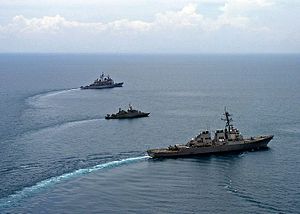The who, what, where, when and how of China’s HD-981 oil rig foray into Vietnamese waters have been addressed comprehensively, both by commentators here at The Diplomat and elsewhere. The enduring question, as with many of China’s provocative actions in the Asia-Pacific, remains why? The opacity of China’s internal decision-making processes makes it rather difficult to conclusively answer that question, but a good amount of evidence suggests that the oil rig crisis with Vietnam was manufactured to test the mettle of ASEAN states and the United States. It gives Beijing an opportunity to gauge the international response to China asserting its maritime territorial claims.
As Carl Thayer points out on this blog and M. Taylor Fravel said in an interview with The New York Times, the China National Offshore Oil Company’s decision to move oil rig HD-981 was a premeditated move of territorial assertion. CNOOC may be a state-owned enterprise but the decision to move this $1 billion asset into an area with questionable hydrocarbon reserves while also inciting a diplomatic crisis speaks to the planned, political nature of this move. The fact that approximately 80 PLAN and Chinese coast guard ships accompanied the rig reinforces the notion that China was making a strategic push to assert its territorial claims in the region.
The question of why China chose to escalate with Vietnam specifically is perhaps slightly easier to answer. Several analysts have already noted that China caught the world off-guard by choosing to escalate its territorial dispute with Vietnam given that relations between the two countries were improving as recently as fall 2013. Additionally, a certain degree of camaraderie exists between the Communist Party of Vietnam (CPV) and the Chinese Communist Party (CCP). For China to suddenly risk a relatively stable bilateral relationship through an underlying rivalry seemed brazen and irresponsible.
On the contrary, if China had to push any dispute in the South China Sea to test the mettle of the United States and ASEAN, Vietnam was perhaps the most fitting candidate. As Tuong Vu told the New York Times, a political debate exists within Vietnam about whether the country should remain close to China or pursue closer relations with the west, with the former faction wielding considerably more influence. With this in mind, China gambled with a good degree of confidence that despite the oil rig provocation, Vietnam would respond with rhetoric and restraint — not force.
To this end, only Chinese coast guard vessels rammed Vietnamese ships and hit them with water cannons — the PLAN remained in a support function, ensuring that whatever kinetic coercion was used was not explicitly originating from a military vessel (although Vietnam did not entirely buy this interpretation). Furthermore, before China can begin trying its luck with U.S. allies in the region, such the Philippines, which recently signed a ten-year defense facility sharing deal with the United States, it must see if the United States is willing to defend its self-stated interests in the region.
Whereas with the Philippines, South Korea, and Japan the United States is treaty-bound to take action, in the case of other disputes in the South China Sea, particularly the Paracel Islands dispute between Vietnam and China, all the United States has to do is demonstrate that it is willing to stand up for the interests it has identified in the past, including freedom of navigation, the peaceful resolution of all conflicts, and the non-use of coercion and intimidation in disputes. With HD-981, China has challenged the United States on all three. Additionally, given ExxonMobil’s interests in the waters, HD-981 is also impeding U.S. commercial interests in the region. So far, the United States’ response — a statement calling China’s behavior “provocative” — is insufficiently costly to China to deter such behavior in the future.
Finally, China timed this coercive move as U.S. President Barack Obama left Asia and just prior to the meeting of ASEAN Heads of Government/State in Naypyidaw, Myanmar this past weekend. In doing so, China was taking a risk: the move would doubtless draw massive international attention and condemnation. However, as the ASEAN Summit statement demonstrates, China still has an assurance that regional leaders are insufficiently united to put forth a joint front against Chinese coercion in the South China Sea. While it is significant that ASEAN Foreign Ministers issued a separate statement, the “internationalization” of disputes that China dreads has not yet come to pass (and likely will not anytime soon).
Similarly, as the United States grows old, weary and underfunded as the global policeman, this oil rig debacle sits in the same category of global crises as Syria and Ukraine — just without the same sort of political urgency. By avoiding a U.S. treaty ally or major partner, China seeks to paint the U.S. as unable to assert its interests in the region. A negative consequence of this is that other states engaged in territorial disputes with China will seek to unilaterally militarize to offset their reliance on U.S. security guarantees, potentially creating a headache for China later in the future.
The decision to move oil rig HD-981 into disputed waters matches China’s decision to impose an air defense identification zone (ADIZ) over the East China Sea in terms of signaling China’s appetite to unilaterally pursue its maritime territorial claims. China has said that the oil rig will remain in these waters until August this year. What ultimately sets this episode apart from any other is that it is the first time China has placed an asset this expensive within the exclusive economic zone (EEZ) of another state. And Vietnam isn’t a pushover of a state either — it has a more-than-modest maritime capacity that could result in an armed altercation with China. Overall, in the past six months, we’ve seen China more assertive than ever in pursuing its claims and, for the moment, it is succeeding.

































